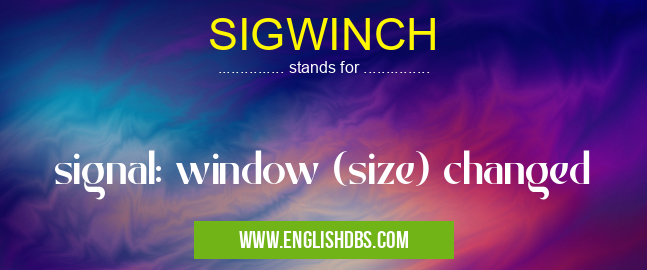What does SIGWINCH mean in UNIX COMMANDS
SIGWINCH is an abbreviation for a signal in computer programming that stands for “window changed.†It is used to indicate that the size of a computer window has been modified, usually by the user resizing it. This signal is sent to programs running inside the window so that they can adjust their content accordingly. In this way, applications are kept up-to-date and responsive to a user's needs.

SIGWINCH meaning in Unix Commands in Computing
SIGWINCH mostly used in an acronym Unix Commands in Category Computing that means signal: window (size) changed
Shorthand: SIGWINCH,
Full Form: signal: window (size) changed
For more information of "signal: window (size) changed", see the section below.
Explanation
The SIGWINCH signal is sent when an application window has been changed in size, typically by a user dragging or resizing it using a mouse or other input device. Although most graphical user interfaces will automatically adjust the content of an application window as it changes size, some programs may require extra assistance to properly manage the contents that are displayed within them. When this happens, SIGWINCH is sent to alert these programs that they need to resize their internal structures and re-render their contents appropriately so that things fit correctly in the newly sized window.
Essential Questions and Answers on signal: window (size) changed in "COMPUTING»UNIX"
What is the purpose of SIGWINCH?
SIGWINCH is a signal sent to a program when the size of its containing terminal window has changed. It is typically handled by the program adjusting its display to fit the new window size.
How do I know if my terminal has sent a SIGWINCH signal?
When your terminal window is resized, your application may handle it and automatically adjust itself to fit the new dimensions of the window. If it does not happen automatically, you can use tools like strace or gdb to look for a SIGWINCH signal in your program's process trace.
What can I do if my app doesn't seem to be responding to SIGWINCH?
Check that your program does indeed recognize and handle input from this signal by using debugging tools such as strace or gdb with the -s flag. You can also check the manual page for the application for details on how it responds to SIGWINCH signals. If these efforts fail, you should contact the authors or maintainers of your software for guidance.
What happens if I don't handle SIGWINCH?
If your application does not respond to SIGWINCH signals, then when your terminal window changes size, nothing will happen within the app and its view will remain unchanged regardless of any changes in its containing window.
When would I need to use SIGWINCH?
Any time you want an active application to adjust its display output according to changes in its container window, then you should be making sure that it responds properly to SIGWINCH signals from that window.
Can I ignore SIGWINCH signals?
Yes, you can opt out of responding to these signals if needed but that won't likely result in user experience improvements compared with handling them appropriately. If instead you choose not respond then expect some user frustration if they have difficulty accessing information due a shell window that's too small or too large.
Does every program need to handle sigwinch?
It depends; while some programs might require response adjustments when their windows change size (i.e., terminals), others won't benefit from such responsiveness (such as text editors). Ultimately, developers must decide what response patterns are most beneficial for their apps.
Does sigwinch impact performance?
No; because Sigwinch is only sent once when a given windowns size changes, responding appropriately should not cause substantial overhead on performance.
How do I know which terminal applications support sigwinch?
Consult documentation from both terminal applications and any programs running within them; responsive applications should specify this support somewhere in either their user or implementation documentation.
Final Words:
SIGWINCH provides an important signaling mechanism for controlling how windowed applications behave on devices with graphical user interfaces. By sending this signal whenever a window's size changes, it ensures that applications stay up-to-date and appear correctly according to those changes. Ultimately, this makes using computers more convenient and efficient for end users who want their computing experience tailored precisely to their individual needs.
